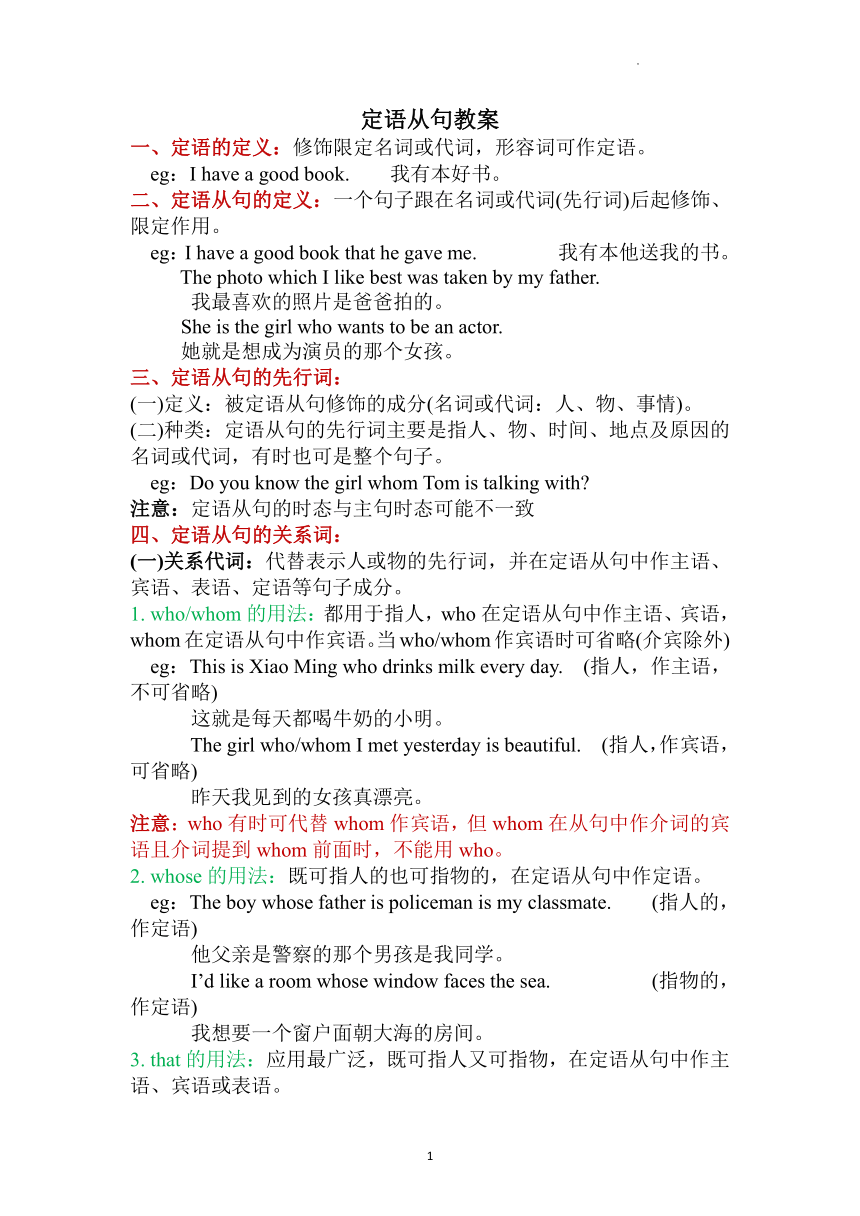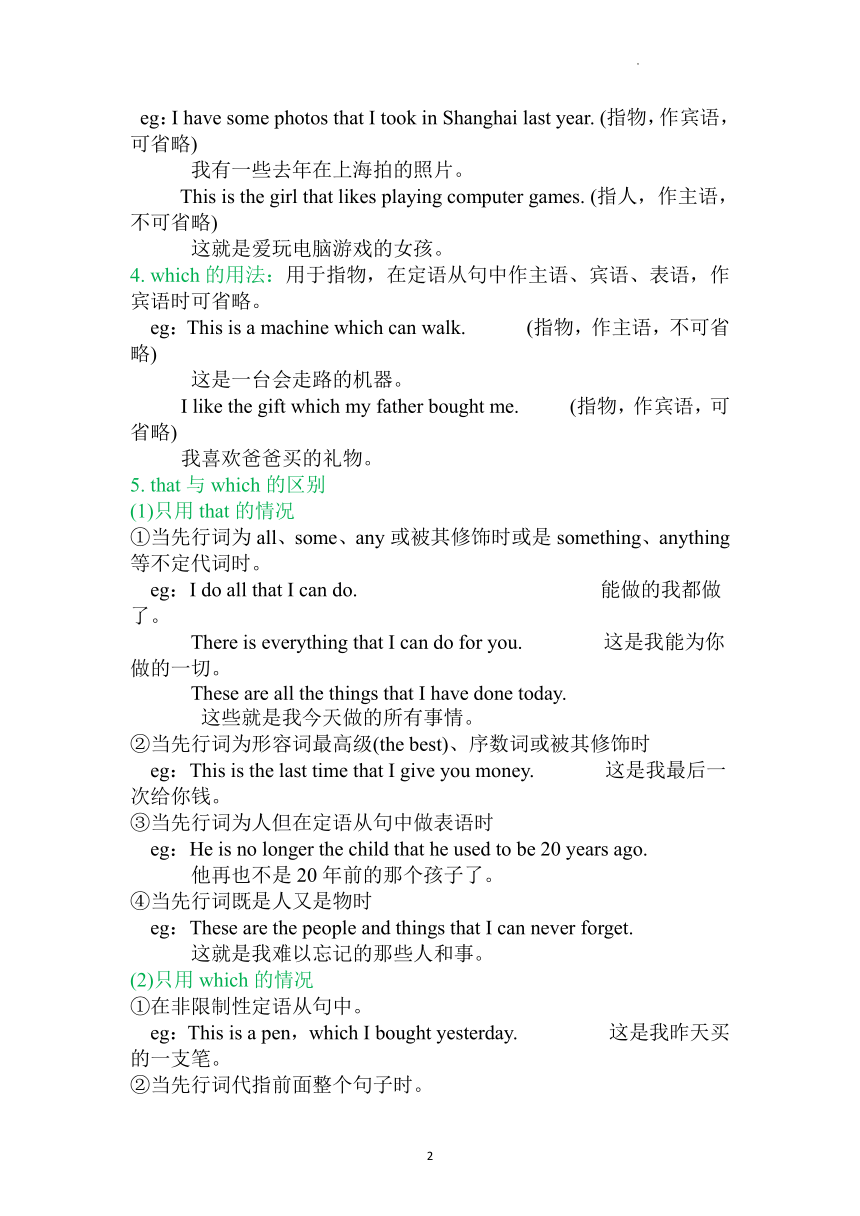2022年中考专区二轮专题英语定语从句教案(表格式)
文档属性
| 名称 | 2022年中考专区二轮专题英语定语从句教案(表格式) |  | |
| 格式 | docx | ||
| 文件大小 | 34.2KB | ||
| 资源类型 | 教案 | ||
| 版本资源 | 通用版 | ||
| 科目 | 英语 | ||
| 更新时间 | 2022-04-22 15:23:27 | ||
图片预览


文档简介
定语从句教案
一、定语的定义:修饰限定名词或代词,形容词可作定语。
eg:I have a good book. 我有本好书。
二、定语从句的定义:一个句子跟在名词或代词(先行词)后起修饰、限定作用。
eg:I have a good book that he gave me. 我有本他送我的书。
The photo which I like best was taken by my father.
我最喜欢的照片是爸爸拍的。
She is the girl who wants to be an actor.
她就是想成为演员的那个女孩。
三、定语从句的先行词:
(一)定义:被定语从句修饰的成分(名词或代词:人、物、事情)。
(二)种类:定语从句的先行词主要是指人、物、时间、地点及原因的名词或代词,有时也可是整个句子。
eg:Do you know the girl whom Tom is talking with
注意:定语从句的时态与主句时态可能不一致
四、定语从句的关系词:
(一)关系代词:代替表示人或物的先行词,并在定语从句中作主语、宾语、表语、定语等句子成分。
1. who/whom的用法:都用于指人,who在定语从句中作主语、宾语,whom在定语从句中作宾语。当who/whom作宾语时可省略(介宾除外)
eg:This is Xiao Ming who drinks milk every day. (指人,作主语,不可省略)
这就是每天都喝牛奶的小明。
The girl who/whom I met yesterday is beautiful. (指人,作宾语,可省略)
昨天我见到的女孩真漂亮。
注意:who有时可代替whom作宾语,但whom在从句中作介词的宾语且介词提到whom前面时,不能用who。
2. whose的用法:既可指人的也可指物的,在定语从句中作定语。
eg:The boy whose father is policeman is my classmate. (指人的,作定语)
他父亲是警察的那个男孩是我同学。
I’d like a room whose window faces the sea. (指物的,作定语)
我想要一个窗户面朝大海的房间。
3. that的用法:应用最广泛,既可指人又可指物,在定语从句中作主语、宾语或表语。
eg:I have some photos that I took in Shanghai last year. (指物,作宾语,可省略)
我有一些去年在上海拍的照片。
This is the girl that likes playing computer games. (指人,作主语,不可省略)
这就是爱玩电脑游戏的女孩。
4. which的用法:用于指物,在定语从句中作主语、宾语、表语,作宾语时可省略。
eg:This is a machine which can walk. (指物,作主语,不可省略)
这是一台会走路的机器。
I like the gift which my father bought me. (指物,作宾语,可省略)
我喜欢爸爸买的礼物。
5. that与which的区别
(1)只用that的情况
①当先行词为all、some、any或被其修饰时或是something、anything等不定代词时。
eg:I do all that I can do. 能做的我都做了。
There is everything that I can do for you. 这是我能为你做的一切。
These are all the things that I have done today.
这些就是我今天做的所有事情。
②当先行词为形容词最高级(the best)、序数词或被其修饰时
eg:This is the last time that I give you money. 这是我最后一次给你钱。
③当先行词为人但在定语从句中做表语时
eg:He is no longer the child that he used to be 20 years ago.
他再也不是20年前的那个孩子了。
④当先行词既是人又是物时
eg:These are the people and things that I can never forget.
这就是我难以忘记的那些人和事。
(2)只用which的情况
①在非限制性定语从句中。
eg:This is a pen,which I bought yesterday. 这是我昨天买的一支笔。
②当先行词代指前面整个句子时。
eg:The boy gets high marks,which makes his parents happy.
关系副词:
代替表示时间、地点、原因的先行词,并在从句中作时间状语、地点状语和原因状语,不可省略。
1. when的用法:指时间,在定语从句中作时间状语。先行词通常为time、day、week等表示时间的名词。常可用on which,in which,during which等替代。
eg:I will remember the days when we work. 我会记得我们一起工作的时间。
注意:当先行词为时间名词,但在从句中不做时间状语时,要用that/which。
(2) where的用法:指地点,在定语从句中作地点状语。先行词通常为place、house、country等表示地点的名词和表示抽象概念的场合、地步、境地(point、situation、stage等)。常可用in which,at which等替代。
eg:This is the classroom where we study. 这是我们学习的地方。
注意:当先行词为地点名词,但在从句中不做地点状语时,要用that/which。
(3) why的用法:指原因,在定语从句中作原因状语。先行词通常为reason,可用for which替代。
eg:This is the reason why he was late. 这就是他迟到的原因。
The reason why I work hard is that I want to make you better.
注意:当先行词为原因名词,但在从句中不做状语时,要用that/which。
(三)关系代词与关系副词的区别:
★若先行词在定语从句中做主语、宾语、表语等时,要用关系代词;若先行词在定语从句中做状语时,要用关系副词。
课堂练习:
1.这是我想说的答案。
2.这是我喜欢的女生。
3.这是我爷爷盖的房子。
4.这是我爷爷住的房子。
5. The price of the house he bought has risen a lot.
6. This is the place we are able to meet many new friends.
7. He has just bought a new magazine cover is missing.
A. that B. which C. who D. whose
8. This is the situation we have to work hard.
A. which B. / C. where D. that
一、定语的定义:修饰限定名词或代词,形容词可作定语。
eg:I have a good book. 我有本好书。
二、定语从句的定义:一个句子跟在名词或代词(先行词)后起修饰、限定作用。
eg:I have a good book that he gave me. 我有本他送我的书。
The photo which I like best was taken by my father.
我最喜欢的照片是爸爸拍的。
She is the girl who wants to be an actor.
她就是想成为演员的那个女孩。
三、定语从句的先行词:
(一)定义:被定语从句修饰的成分(名词或代词:人、物、事情)。
(二)种类:定语从句的先行词主要是指人、物、时间、地点及原因的名词或代词,有时也可是整个句子。
eg:Do you know the girl whom Tom is talking with
注意:定语从句的时态与主句时态可能不一致
四、定语从句的关系词:
(一)关系代词:代替表示人或物的先行词,并在定语从句中作主语、宾语、表语、定语等句子成分。
1. who/whom的用法:都用于指人,who在定语从句中作主语、宾语,whom在定语从句中作宾语。当who/whom作宾语时可省略(介宾除外)
eg:This is Xiao Ming who drinks milk every day. (指人,作主语,不可省略)
这就是每天都喝牛奶的小明。
The girl who/whom I met yesterday is beautiful. (指人,作宾语,可省略)
昨天我见到的女孩真漂亮。
注意:who有时可代替whom作宾语,但whom在从句中作介词的宾语且介词提到whom前面时,不能用who。
2. whose的用法:既可指人的也可指物的,在定语从句中作定语。
eg:The boy whose father is policeman is my classmate. (指人的,作定语)
他父亲是警察的那个男孩是我同学。
I’d like a room whose window faces the sea. (指物的,作定语)
我想要一个窗户面朝大海的房间。
3. that的用法:应用最广泛,既可指人又可指物,在定语从句中作主语、宾语或表语。
eg:I have some photos that I took in Shanghai last year. (指物,作宾语,可省略)
我有一些去年在上海拍的照片。
This is the girl that likes playing computer games. (指人,作主语,不可省略)
这就是爱玩电脑游戏的女孩。
4. which的用法:用于指物,在定语从句中作主语、宾语、表语,作宾语时可省略。
eg:This is a machine which can walk. (指物,作主语,不可省略)
这是一台会走路的机器。
I like the gift which my father bought me. (指物,作宾语,可省略)
我喜欢爸爸买的礼物。
5. that与which的区别
(1)只用that的情况
①当先行词为all、some、any或被其修饰时或是something、anything等不定代词时。
eg:I do all that I can do. 能做的我都做了。
There is everything that I can do for you. 这是我能为你做的一切。
These are all the things that I have done today.
这些就是我今天做的所有事情。
②当先行词为形容词最高级(the best)、序数词或被其修饰时
eg:This is the last time that I give you money. 这是我最后一次给你钱。
③当先行词为人但在定语从句中做表语时
eg:He is no longer the child that he used to be 20 years ago.
他再也不是20年前的那个孩子了。
④当先行词既是人又是物时
eg:These are the people and things that I can never forget.
这就是我难以忘记的那些人和事。
(2)只用which的情况
①在非限制性定语从句中。
eg:This is a pen,which I bought yesterday. 这是我昨天买的一支笔。
②当先行词代指前面整个句子时。
eg:The boy gets high marks,which makes his parents happy.
关系副词:
代替表示时间、地点、原因的先行词,并在从句中作时间状语、地点状语和原因状语,不可省略。
1. when的用法:指时间,在定语从句中作时间状语。先行词通常为time、day、week等表示时间的名词。常可用on which,in which,during which等替代。
eg:I will remember the days when we work. 我会记得我们一起工作的时间。
注意:当先行词为时间名词,但在从句中不做时间状语时,要用that/which。
(2) where的用法:指地点,在定语从句中作地点状语。先行词通常为place、house、country等表示地点的名词和表示抽象概念的场合、地步、境地(point、situation、stage等)。常可用in which,at which等替代。
eg:This is the classroom where we study. 这是我们学习的地方。
注意:当先行词为地点名词,但在从句中不做地点状语时,要用that/which。
(3) why的用法:指原因,在定语从句中作原因状语。先行词通常为reason,可用for which替代。
eg:This is the reason why he was late. 这就是他迟到的原因。
The reason why I work hard is that I want to make you better.
注意:当先行词为原因名词,但在从句中不做状语时,要用that/which。
(三)关系代词与关系副词的区别:
★若先行词在定语从句中做主语、宾语、表语等时,要用关系代词;若先行词在定语从句中做状语时,要用关系副词。
课堂练习:
1.这是我想说的答案。
2.这是我喜欢的女生。
3.这是我爷爷盖的房子。
4.这是我爷爷住的房子。
5. The price of the house he bought has risen a lot.
6. This is the place we are able to meet many new friends.
7. He has just bought a new magazine cover is missing.
A. that B. which C. who D. whose
8. This is the situation we have to work hard.
A. which B. / C. where D. that
同课章节目录
- 词法
- 名词
- 动词和动词短语
- 动词语态
- 动词时态
- 助动词和情态动词
- 非谓语动词
- 冠词
- 代词
- 数词和量词
- 形容词副词及其比较等级
- 介词和介词短语
- 连词和感叹词
- 构词法
- 相似、相近词比较
- 句法
- 陈述句
- 一般疑问句和否定疑问句
- 特殊疑问句及选择疑问句
- 反意疑问句
- 存在句(There be句型)
- 宾语从句
- 定语从句
- 状语从句
- 主谓一致问题
- 简单句
- 并列句
- 复合句
- 主谓一致
- 主、表语从句
- 名词性从句
- 直接引语和间接引语
- 虚拟语气
- 感叹句
- 强调句
- 倒装句
- 祈使句
- 句子的成分
- 句子的分类
- 题型专区
- 单项选择部分
- 易错题
- 完形填空
- 阅读理解
- 词汇练习
- 听说训练
- 句型转换
- 补全对话
- 短文改错
- 翻译
- 书面表达
- 任务型阅读
- 语法填空
- 其他资料
